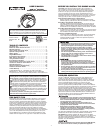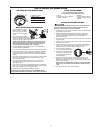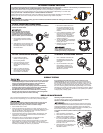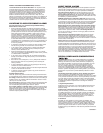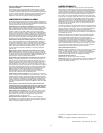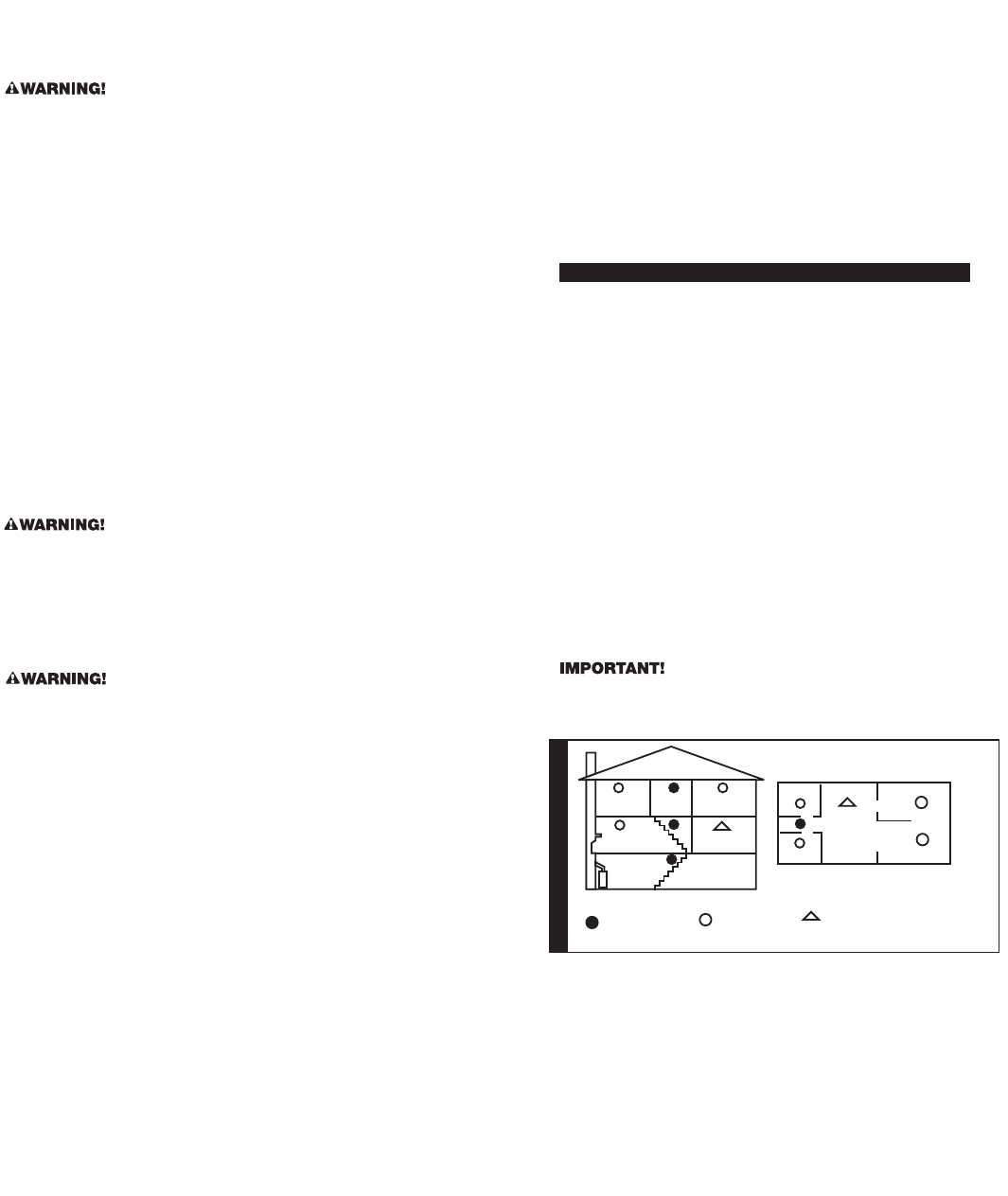
IF THIS SMOKE ALARM SOUNDS
RESPONDING TO AN ALARM
During an alarm, you will hear a loud, repeating horn pattern:
3 beeps, pause, 3 beeps, pause. The LED will flash rapidly.
• If the unit alarms and you are not testing the unit, it is warning
you of a potentially dangerous situation that requires your
immediate attention. NEVER ignore any alarm. Ignoring the
alarm may result in injury or death.
• Never remove the batteries from a battery operated Smoke
Alarm to stop an unwanted alarm (caused by cooking smoke,
etc.). Removing batteries disables the alarm so it cannot sense
smoke, and removes your protection. Instead open a window
or fan the smoke away from the unit. The alarm will reset auto-
matically.
• If the unit alarms get everyone out of the house immediately.
4
WHAT TO DO IN CASE OF FIRE
• Don’t panic; stay calm. Follow your family escape plan.
• Get out of the house as quickly as possible. Don’t stop to get
dressed or collect anything.
• Feel doors with the back of your hand before opening them.
If a door is cool, open it slowly. Don’t open a hot door. Keep doors
and windows closed, unless you must escape through them.
• Cover your nose and mouth with a cloth (preferably damp).
Take short, shallow breaths.
• Meet at your planned meeting
place outside your home,
and do a head count to make sure everybody got out safely.
• Call the Fire Department as soon as possible from outside.
Give your address, then your name.
• Never go back inside a burning building for any reason.
• Contact your Fire Department for ideas on making your home safer.
Alarms have various limitations. See "Limitations of Smoke Alarms"
for details.
USING THE SILENCE FEATURE
The Silence Feature can temporarily quiet an unwanted alarm for up to
15 minutes. To use this feature, press the “Push to Test/Silence” button on
the cover. If the unit will not silence and no heavy smoke is present,
or if it stays in silence mode continuously, it should be replaced
immediately. The LED will continue to flash rapidly while in silence.
The Silence Feature does not disable the unit—it makes it temporarily
less sensitive to smoke. For your safety, if smoke around the unit is
dense enough to suggest a potentially dangerous situation, the unit
will stay in alarm or may re-alarm quickly. If you do
not know the
source of the smoke, do not assume it is an unwanted alarm. Not
responding to an alarm can result in property loss, injury, or death.
SILENCING THE LOW BATTERY WARNING
This silence feature can temporarily quiet the low battery warning “chirp”
for up to 8 hours. You can silence the low battery warning “chirp” by
pressing the Test/Silence button on the alarm cover.
Once the low battery warning “chirp” silence feature is activated, the unit
continues to flash the Green light twice a minute for 8 hours. After
8
hours, the low battery “chirp” will resume. Replace the batteries as
soon as possible; this unit will not operate without battery power!
To deactivate this feature: Press the Test/Silence button again. The unit
will go into Test Mode and the low battery warning will resume (LED
flashes and unit sounds “chirp” once a minute).
IF YOU SUSPECT A PROBLEM
Smoke Alarms may not operate properly because of dead, missing or
weak batteries, a build-up of dirt, dust or grease on the Smoke Alarm
cover, or installation in an improper location. Clean the Smoke Alarm as
described in “Regular Maintenance,” and install a fresh battery, then test
the Smoke Alarm again. If it fails to test properly when you use the test
button, or if the problem persists, replace the Smoke Alarm immediately.
• If you hear a “chirp” about once a minute, replace the battery.
• If you experience frequent
non-emergency alarms (like those
caused by cooking smoke), try relocating the Smoke Alarm.
• If the alarm sounds when no smoke is visible, try cleaning or
relocating the Smoke Alarm. The cover may be dirty.
• If the alarm does not sound during testing, try installing a new
battery, and make sure it is snapped in securely.
• If the alarm sounds 3 rapid “chirps” every minute; LED flashes
approximately once a minute. MALFUNCTION: the device is not
working properly and needs to be replaced.
If the Smoke Alarm is still not operating properly, and it is still under
warranty,
please see “How to Obtain Warranty Service” in the Limited
Warranty.
Do not try fixing the alarm yourself – this will void your warranty!
RECOMMENDED LOCATIONS FOR
SMOKE ALARMS
Installing Smoke Alarms in Single-Family Residences
The National Fire Protection Association (NFPA), recommends one
Smoke Alarm on every floor, in every sleeping area, and in every bed-
room. In new construction, the Smoke Alarms must be AC powered and
interconnected. See “Agency Placement Recommendations” for details.
For additional coverage, it is recommended that you install a Smoke
Alarm in all rooms, halls, storage areas, finished attics, and basements,
where temperatures norm
ally remain between 40˚ F (4˚ C) and 100˚ F
(38˚ C). Make sure no door or other obstruction could keep smoke from
reaching the Smoke Alarms.
More specifically, install Smoke Alarms:
•
On every level of your home, including finished attics and basements.
• Inside every bedroom, especially if people sleep with doors closed.
• In the hall near every sleeping area. If your home has multiple sleep-
ing areas, install a unit in each. If a hall is over 40 feet (12 meters)
long, install an alarm at each end.
• At the top of the
first-to-second floor stairway, and at bottom of
basement stairway.
Specific requirements for Smoke Alarm installation vary from state to
state and from region to region. Check with your local Fire Department
for current requirements in your area. It is recommended AC or AC/DC
units be interconnected for added protection.
BEDROOM
BEDROOM
HALL
LIVING ROOM KITCHEN
BEDROOM
KITCHEN
DINING ROOM
KEY:
HOMES
BEDROOM
BEDROOM
HALL
LIVING ROOM KITCHEN
FINISHED BASEMENT
BEDROOM
BEDROOM
LIVING ROOM
DINING ROOM
MULTI-STORY RESIDENCE
SINGLE-STORY RESIDENCE, APARTMENT,
MOBILE HOME
EXISTING HOMES
KITCHEN
REQUIRED TO
MEET NFPA
RECOMMENDATIONS
RECOMMENDED
FOR ADDITIONAL
PROTECTION
KEY:
SMOKE ALARMS WITH SILENCE
FEATURES RECOMMENDED FOR
ADDITIONAL PROTECTION
AGENCY PLACEMENT RECOMMENDATIONS
NFPA 72 (National Fire Code) Chapter 11
“For your information, the National Fire Protection Association's
Standard 72, reads as follows:”
“11.5.1 One- and Two-Family Dwelling Units.”
“11.5.1.1 Smoke Detection. Where required by applicable laws, codes, or
standards for the specified occupancy, approved single- and multiple-
station Smoke Alarms shall be installed as follows: (1) In all sleeping
rooms Exception: Smoke Alarms shall not be required in sleeping rooms
in existing one- and two-family dwelling units. (2) Out
side of each
separate sleeping area, in immediate vicinity of the sleeping rooms.
(3) On each level of the dwelling unit, including basements Exception: In
existing one- and two family dwelling units, approved Smoke Alarms
powered by batteries are permitted.”
Continued...



